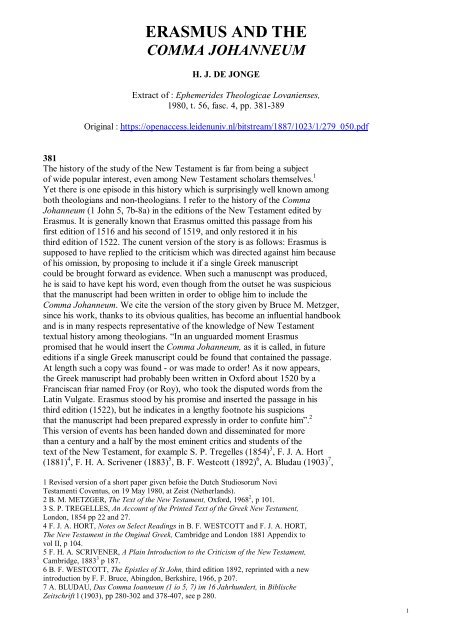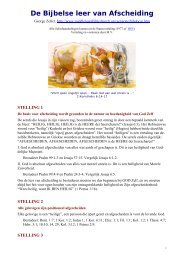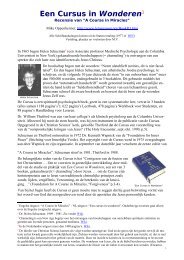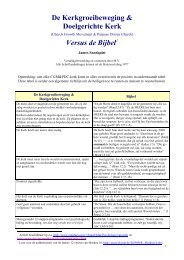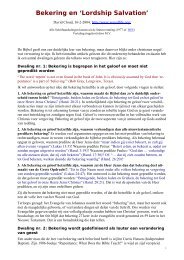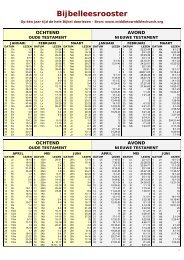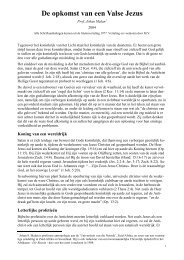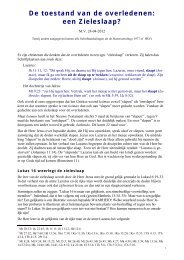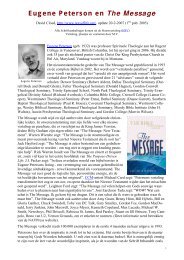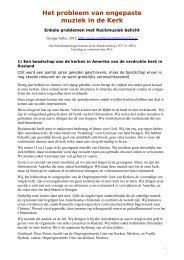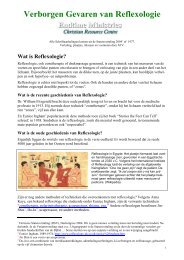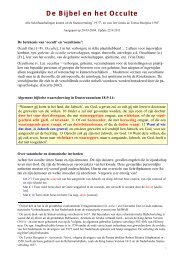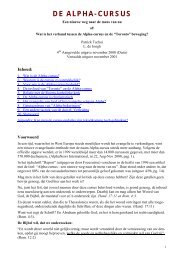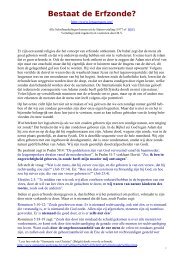erasmus and the comma johanneum - Marc Verhoeven
erasmus and the comma johanneum - Marc Verhoeven
erasmus and the comma johanneum - Marc Verhoeven
Create successful ePaper yourself
Turn your PDF publications into a flip-book with our unique Google optimized e-Paper software.
ERASMUS AND THE<br />
COMMA JOHANNEUM<br />
H. J. DE JONGE<br />
Extract of : Ephemerides Theologicae Lovanienses,<br />
1980, t. 56, fasc. 4, pp. 381-389<br />
Original : https://openaccess.leidenuniv.nl/bitstream/1887/1023/1/279_050.pdf<br />
381<br />
The history of <strong>the</strong> study of <strong>the</strong> New Testament is far from being a subject<br />
of wide popular interest, even among New Testament scholars <strong>the</strong>mselves. 1<br />
Yet <strong>the</strong>re is one episode in this history which is surprisingly well known among<br />
both <strong>the</strong>ologians <strong>and</strong> non-<strong>the</strong>ologians. I refer to <strong>the</strong> history of <strong>the</strong> Comma<br />
Johanneum (1 John 5, 7b-8a) in <strong>the</strong> editions of <strong>the</strong> New Testament edited by<br />
Erasmus. It is generally known that Erasmus omitted this passage from his<br />
first edition of 1516 <strong>and</strong> his second of 1519, <strong>and</strong> only restored it in his<br />
third edition of 1522. The cunent version of <strong>the</strong> story is as follows: Erasmus is<br />
supposed to have replied to <strong>the</strong> criticism which was directed against him because<br />
of his omission, by proposing to include it if a single Greek manuscript<br />
could be brought forward as evidence. When such a manuscnpt was produced,<br />
he is said to have kept his word, even though from <strong>the</strong> outset he was suspicious<br />
that <strong>the</strong> manuscript had been written in order to oblige him to include <strong>the</strong><br />
Comma Johanneum. We cite <strong>the</strong> version of <strong>the</strong> story given by Bruce M. Metzger,<br />
since his work, thanks to its obvious qualities, has become an influential h<strong>and</strong>book<br />
<strong>and</strong> is in many respects representative of <strong>the</strong> knowledge of New Testament<br />
textual history among <strong>the</strong>ologians. “In an unguarded moment Erasmus<br />
promised that he would insert <strong>the</strong> Comma Johanneum, as it is called, in future<br />
editions if a single Greek manuscript could be found that contained <strong>the</strong> passage.<br />
At length such a copy was found - or was made to order! As it now appears,<br />
<strong>the</strong> Greek manuscript had probably been written in Oxford about 1520 by a<br />
Franciscan friar named Froy (or Roy), who took <strong>the</strong> disputed words from <strong>the</strong><br />
Latin Vulgate. Erasmus stood by his promise <strong>and</strong> inserted <strong>the</strong> passage in his<br />
third edition (1522), but he indicates in a lengthy footnote his suspicions<br />
that <strong>the</strong> manuscript had been prepared expressly in order to confute him”. 2<br />
This version of events has been h<strong>and</strong>ed down <strong>and</strong> disseminated for more<br />
than a century <strong>and</strong> a half by <strong>the</strong> most eminent critics <strong>and</strong> students of <strong>the</strong><br />
text of <strong>the</strong> New Testament, for examplc S. P. Tregelles (1854) 3 , F. J. A. Hort<br />
(1881) 4 , F. H. A. Scrivener (1883) 5 , B. F. Westcott (1892) 6 , A. Bludau (1903) 7 ,<br />
1 Revised version of a short paper givcn befoie <strong>the</strong> Dutch Studiosorum Novi<br />
Testamenti Coventus, on 19 May 1980, at Zeist (Ne<strong>the</strong>rl<strong>and</strong>s).<br />
2 B. M. METZGER, The Text of <strong>the</strong> New Testament, Oxford, 1968 2 , p 101.<br />
3 S. P. TREGELLES, An Account of <strong>the</strong> Printed Text of <strong>the</strong> Greek New Testament,<br />
London, 1854 pp 22 <strong>and</strong> 27.<br />
4 F. J. A. HORT, Notes on Select Readings in B. F. WESTCOTT <strong>and</strong> F. J. A. HORT,<br />
The New Testament in <strong>the</strong> Onginal Greek, Cambridge <strong>and</strong> London 1881 Appendix to<br />
vol II, p 104.<br />
5 F. H. A. SCRIVENER, A Plain Introduction to <strong>the</strong> Criticism of <strong>the</strong> New Testament,<br />
Cambridge, 1883 3 p 187.<br />
6 B. F. WESTCOTT, The Epistles of St John, third edition 1892, reprinted with a new<br />
introduction by F. F. Bruce, Abingdon, Berkshire, 1966, p 207.<br />
7 A. BLUDAU, Das Comma Ioanneum (1 ίο 5, 7) im 16 Jahrhundert, in Biblische<br />
Zeitschrift l (1903), pp 280-302 <strong>and</strong> 378-407, see p 280.<br />
1
382<br />
Eb. Nestle (1903) 8 , C. H. Turner (1924)9 <strong>and</strong> F. G. Kenyon (1901, 1912/1926) 10<br />
The same tradition has also been disseminated in a number of works intended<br />
for a wider public interested in <strong>the</strong> textual transmission of <strong>the</strong> Bible or o<strong>the</strong>r<br />
ancient literature, for example in <strong>the</strong> works of W. A. Copinger (1897) 11 ,<br />
T. H. Darlow <strong>and</strong> H. F. Moule (1903) 12 , L. D. Reynolds <strong>and</strong> N. G. Wilson<br />
(1974) 13 <strong>and</strong> J. Finegan (1974/5). 14 The story of <strong>the</strong> way Erasmus is said<br />
to have honoured his promise is also h<strong>and</strong>ed down in <strong>the</strong> literature which<br />
refers specifically to <strong>the</strong> humanist himself, for example by P. S. Allen (1910) 15<br />
<strong>and</strong> by <strong>the</strong> authors of such excellent biographies as those by Preserved Smith<br />
(1923) 16 <strong>and</strong> R. H. Bainton (1969). 17 How often must those who lecture in <strong>the</strong><br />
New Testament or textual criticism at universities <strong>the</strong> world over have passed<br />
on <strong>the</strong> story of <strong>the</strong> good faith with which a deceived Erasmus kept his word,<br />
to <strong>the</strong> students in <strong>the</strong>ir lecture halls! The writer of <strong>the</strong>se lines cannot plead<br />
innocence in this respect.<br />
Yet <strong>the</strong>re are a number of difficulties in <strong>the</strong> story of Erasmus’ promise <strong>and</strong><br />
its consequences, which arouse a certain suspicion of its truthfulness.<br />
In <strong>the</strong> first place it is remarkable that <strong>the</strong>re is no trace of this tradition<br />
in <strong>the</strong> works of <strong>the</strong> great experts in <strong>the</strong> history of <strong>the</strong> text of <strong>the</strong> New<br />
Testament in <strong>the</strong> seventeenth <strong>and</strong> eighteenth centuries. We find not a word<br />
of it in Richard Simon’s Histoire critique du texte du Nouveau Testament<br />
(1689) even though a special chapter of this work (ch. XVIII) is devoted to <strong>the</strong><br />
Comma Johanneum. John Mills too is completely silent about Erasmus’ promise,<br />
although in paragraph 1138 of <strong>the</strong> Prolegomena to his Novum Testamentum<br />
Graecum he refers specifically to <strong>the</strong> inclusion of <strong>the</strong> Comma Johanneum in <strong>the</strong><br />
third edition of Erasmus’ New Testament. He even adds <strong>the</strong> interesting detail<br />
that Erasmus included <strong>the</strong> Comma Johanneum as early as June 1521, in a separate<br />
edition of his Latin translation published by Froben at Basle. This detail is<br />
important because it helps to determine <strong>the</strong> period of time within which<br />
Erasmus must have become aware of <strong>the</strong> Comma Johanneum in Greek. He was<br />
8 Eb. NESTLE, Vom Textus Receptus des Griechischen Neuen Testaments (Salz und<br />
Licht 8), Barmen, 1903, p 15.<br />
9 C. H. TURNER, The Early Printed Editions of <strong>the</strong> Greek Testament, Oxford, 1924<br />
p 23.<br />
10 F. G. KENYON, H<strong>and</strong>book to <strong>the</strong> Textual Criticism of <strong>the</strong> Νew Testament London<br />
1901, p 229, 1912 2 (reprintcd 1926), p 270.<br />
11 W. A. COPINGFR, The Bible <strong>and</strong> its Transmission, London 1897 p 140.<br />
12 T. H. DARLOW <strong>and</strong> H. F. MOULE, Historical Catalogue of <strong>the</strong> Printed Editions, of<br />
Holy Scripture, vol II Polyglots, <strong>and</strong> Languages o<strong>the</strong>r than English, London, 1903<br />
reprintcd New York, 1963, p 579.<br />
13 L. D. REYNOLDS <strong>and</strong> N. G. WILSON, Sribes <strong>and</strong> Scholars, Oxford, 1974 2 p 144.<br />
14 J. FINEGAN, Encountering New Testament Manuscripts, Gr<strong>and</strong> Rapids, 1974,<br />
London, 1975, p 57.<br />
15 P. S. ALLEN (ed.), Opus Epistolarum Des Erasmi Roterodami, II Oxford 1910,<br />
p 165. The story is also told by J.-Cl. MARGOLIN, Laski, lecteur et annotateur du<br />
Nouveau Testament d’ Erasme, in J. COPPLNS (ed.), Srinium Erasmianum 2 vols,<br />
Leiden, 1969, I, pp 93-128, see p 104, n. 46.<br />
16 Preserved SMITH, Erasmus, A Study of his Life, Ideals, <strong>and</strong> Place m Histoiy,<br />
New York 1923, pp 165-166.<br />
17 R. H. BAINTON, Erasmus of Christendom, New York, 1969, pp 169-170, <strong>the</strong><br />
same author, The Bible in <strong>the</strong> Reformation, in S. L. GREENSLADE (ed.), The Cambridge<br />
History of <strong>the</strong> Bible, III, Cambridge, 1963, pp 1-37, see p 10.<br />
2
383<br />
still unaware of it in May 1520 when he wrote his apologia Liber tertius<br />
against Edward Lee Thus, he must have received evidence of <strong>the</strong> passage<br />
between May 1520 <strong>and</strong> June 1521. It is not known who brought it to his<br />
attention.<br />
Not only do Simon <strong>and</strong> Mills make no reference to Erasmus’ promise,<br />
J. Clericus does not mention it, ei<strong>the</strong>r in his Ars Critica (1696, often reprinted)<br />
or his commentary on 1 John 5, 7 (1714 2 ). Nor do we find it in J. J. Weitstein<br />
(1751/2) 18 , J. le Long - C. F. Boerner - A. G. Masch (1788/90) 19 ,<br />
J. D. Michaelis (1788) 20 , G. W. Meyer (1802/9) 21 , J. Townley (<strong>the</strong> author of<br />
Biblical Anecdotes, (182l) 22 or in T. F. Dibdin (1827). 21 The earliest reference<br />
to Erasmus’ promise of which I am aware is that of T. H. Horne in 1818. 24<br />
It remams unclear from which source Horne derived his information. He was<br />
too scrupulous a critic to raise any suspicion that he was <strong>the</strong> inventor of <strong>the</strong><br />
whole story. Moreover, Horne himself published a list of more than fifty<br />
volumes, pamphlets of critical notices on <strong>the</strong> Comma Johanneum which had<br />
appeared up to his time. 25 He may thus very well have derived <strong>the</strong> details<br />
from a predecessor but it is scarcely feasible to go through all his matenal again.<br />
A second difficulty is that in <strong>the</strong> retelling of <strong>the</strong> story of Erasmus’ supposed<br />
promise, <strong>the</strong>re are striking variations. Some authors, such as Horne, Darlow<br />
<strong>and</strong> Moule, Kenyon <strong>and</strong> Turner, relate that Erasmus made this promise in <strong>the</strong><br />
controversy with his Spanish opponent Jacobus Lopis Stunica. O<strong>the</strong>rs, among<br />
<strong>the</strong>m Bludau <strong>and</strong> Bainton, say that <strong>the</strong> promise was given to his English<br />
assailant Edward Lee. Yet o<strong>the</strong>rs write, without making a clear distinction,<br />
that Erasmus gave his promise in reaction to <strong>the</strong> criticisms of both Lee <strong>and</strong><br />
Stunica, while o<strong>the</strong>rs again leave it indeterminate, to whom <strong>the</strong> promise was<br />
directed.<br />
Now it is completely impossible that Erasmus could have given his pledge to<br />
Stunica, for he did not address himsell to <strong>the</strong> Spaniard until his Apologia<br />
respondens ad ea quae in Nouo Testamento taxauerat Iacobus Lopis Stunica,<br />
of September 1521. 26 In this apologia he explains, in dealing with 1 John 5,<br />
that he had received a transcript of <strong>the</strong> Comma Johanneum, from a Codex<br />
Britannicus, <strong>and</strong> had inserted it into <strong>the</strong> text of 1 John, which was shortly to<br />
18 J. J. WETSTENIUS, Novum Testamentum Graecum, 2 vols, Amsterdam 1751/2.<br />
19 Jac LE LONG, C. F. BOERNER, A. G. MASCH, Biblio<strong>the</strong>ca Sacra Halle, 1778/90.<br />
20 Johann David MICHAELIS, Einleitung in die gottlichen Schriften des Neuen Bundes,<br />
Gottingen, 1788 4<br />
21 G. W. MEYER, Geschichte der Schrifterklarung, Gottingen, 1802/9.<br />
22 James TOWNLEY, Illustrations of Biblical Literature, exhibiting <strong>the</strong> History <strong>and</strong><br />
Fate of <strong>the</strong> Sacred Writings from <strong>the</strong> Earliest Period to <strong>the</strong> Present Century<br />
London, vol I-II, 1821.<br />
23 T. F. DIBDIN An Introduction to <strong>the</strong> Knowledge of Rare <strong>and</strong> Valuable Editions,<br />
London, vol I, 1827.<br />
24 T. H. HORNL, An Introduction to <strong>the</strong> Critical Study ans Knowledge of <strong>the</strong> Holy<br />
Scripture, vol II, Part II Appendix, London, 1818, p 133.<br />
25 S. P. TREGELLES, An Introduction to <strong>the</strong> Textual Criticism of <strong>the</strong> New Testament, =<br />
Vol IV of T. H. HORNE, An Introduction to <strong>the</strong> Critical Study <strong>and</strong> Knowledge of <strong>the</strong><br />
Holy Scriptures, London, 1856 10 , pp 384 388.<br />
26 Des ERASMUS, Opera Omnia (ed. J. CLERICUS, tom. IX), Leiden, 1706, col 283-<br />
356. This apology figures, also among <strong>the</strong> ‘tractatus’ included in <strong>the</strong> final volumes of<br />
<strong>the</strong> Critici Sacri (ed. J. PLARSON et al.), London, 1660 Frankfurt, 1695, Amsterdam,<br />
1698.<br />
3
384<br />
appear in a new impression of his Novum Testamentum (1522 3 ). Therefore,<br />
Erasmus can hardly have given Stunica any promise containing <strong>the</strong> condition<br />
“if a single Greek manuscript with <strong>the</strong> Comma Johanneum is found”.<br />
Nor did Erasmus give such a promise to Lee at least not in any of <strong>the</strong><br />
surviving correspondence 27 or apologias 28 in which <strong>the</strong> Rotterdammer addressed<br />
Lee.<br />
A third problem is that <strong>the</strong> famous promise of Erasmus is not to be found<br />
anywhere else in his oeuvre. It is thus not surprising that, with one exception,<br />
none of <strong>the</strong> authors known to me who relate <strong>the</strong> story, refer to a specific passage<br />
in Erasmus or in o<strong>the</strong>r sixteenth-century literature, where such a pledge is to be<br />
found. The only exception is Bainton, who himself seems to have become<br />
suspicious <strong>and</strong> eventually includes a reference to a passage which is by no<br />
means a promise, as will be clear from what follows. 29<br />
It is naturally exceptionally difficult, if not impossible in principle to furnish<br />
conclusive proof that someone did not say something. Yet in my opinion<br />
<strong>the</strong>re is sufficient reason to assume that Erasmus, when he chose to insert <strong>the</strong><br />
Comma Johanneum, did not feel himself constrained by any promise. He<br />
explained on several occasions what had led him to include this passage in his<br />
third edition. He did so “so that no one would have occasion to criticise me<br />
out of malice”, ne cui sit causa calumni<strong>and</strong>i 30 or as he expressed it in his<br />
Annotationes on 1 John 5, 7 ne cut sit ansa calumni<strong>and</strong>i. 31 It should be borne in<br />
mind that Lee had written that <strong>the</strong> omission of <strong>the</strong> Comma Johanneum brought<br />
with it <strong>the</strong> danger of a new revival of Arianism. This was of course a very serious<br />
Insinuation. Erasmus had reason to fear that if he were suspected of heretical<br />
sympathies, his Novum Testamentum would miss its exalted goal. This Novum<br />
Testamentum was not in <strong>the</strong> first place intended as an edition of <strong>the</strong> Greek<br />
New Testament, as is incorrectly assumed. It was, in Erasmus’ intention, in <strong>the</strong><br />
first place a new, modern <strong>and</strong> readable translation of <strong>the</strong> New Testament into<br />
Latin. The function of <strong>the</strong> Greek text was secondary, it was to show that<br />
Erasmus’ new version rested on a firm foundation <strong>and</strong> that it was not just a<br />
reckless search for novelty. By his new translation Erasmus hoped to make<br />
<strong>the</strong> words of Christ <strong>and</strong> <strong>the</strong> apostles accessible to a wide circle in clear<br />
<strong>and</strong> easily understood prose. He wished to fill <strong>the</strong> world with <strong>the</strong> philosophia<br />
Christi, <strong>the</strong> simple pious, <strong>and</strong> practical Christianity which would best serve <strong>the</strong><br />
world. To achieve this, as many people as possible had to read <strong>the</strong> New Testament.<br />
But not <strong>the</strong> Vulgate which was full of all sorts of obscurities. A new, more<br />
readable <strong>and</strong> clearer translation was necessary, <strong>and</strong> that was Erasmus’ Novum<br />
27 ALLEN Opus Epistolarum nos 765 <strong>and</strong> 998.<br />
28 Apologia nihil habens … qua respondet duabis invectivis Eduardi Lei, Antwerp<br />
1520 not included in any edition of Erasmus collected works but re-edited in<br />
W. K. FERGUSON (cd.) Erasmi Opuscula The Hague 1933 Responsio ad Annotationes<br />
Ed Lei I Antwerp April 1520 (in Clericus edition tom. IX col. 123-200) II Antwerp<br />
May 1520 (Clericus ibid 199-284).<br />
29 Bainton’s reference is to <strong>the</strong> Responsio ad Annotationes Eduardi Lei in Erasmum<br />
nouas, in Erasmus Liber Tertius E.R. quo respondet rechquis annotationibus Ed Lei<br />
Antwerp May 1520 in Clencus edition this Liber Tertius occurs as Liber alter quo<br />
respondet Lei tom. IX col. 199-284, see col. 275 B C Cf n. 33 below.<br />
30 Erasmus first apology against Stunica ed Clericus tom. IX col. 353 E.<br />
31 Annotationes in N T ed. Clericus tom. VI col. 1080 D.<br />
4
385<br />
Instrumentum from 1519 entitled Novum Testamentum. The goal of Erasmus<br />
undertaking to imbue all Europe with a clear <strong>and</strong> simple gospel threatened to<br />
fall if Erasmus himself were tinged with any suspicion of unorthodoxy. For <strong>the</strong><br />
sake of his ideal Erasmus chose to avoid any occasion for sl<strong>and</strong>er ra<strong>the</strong>r than<br />
persisting in philological accuracy <strong>and</strong> thus condemning himself to<br />
impotence. That was <strong>the</strong> reason why Erasmus included <strong>the</strong> Comma Johanneum<br />
even though he remained convinced that it did not belong to <strong>the</strong> original text<br />
of 1 John. 32<br />
The real reason which induced Erasmus to include <strong>the</strong> Comma Johanneum was<br />
thus clearly his care for his good name <strong>and</strong> for <strong>the</strong> success of his Novum<br />
Testamentum. How <strong>the</strong>n did <strong>the</strong> famous story arise of his promise <strong>and</strong> <strong>the</strong> way<br />
in which he honoured it? It is likely that it grew out of a misinterpretation<br />
of a passage in his Responsio ad Annotationes Eduardi Lei of May 1520. 33<br />
Lee was a truly quarrelsome individual, a myopically conservative <strong>the</strong>ologian,<br />
later archbishop of York who troubled <strong>and</strong> pestered Erasmus for several years<br />
with his criticisms which were unusually mediocre of <strong>the</strong> Novum Instrumen-<br />
tum. 34 Lee was one of several critics who had remarked on <strong>the</strong> absence of <strong>the</strong><br />
Comma Johanncum in <strong>the</strong> first two editions. In 1520 Erasmus felt himself<br />
obliged to make a detailed reply to Lee. In his lengthy discussion of 1 John 5, 7<br />
Erasmus wrote as follows: “Quod si con - tigisset unum exemplar, in quo fuisset,<br />
quod nos legimus, nimirum illinc adjecissem, quod in cseteris aberat. Id quia<br />
non contigit, quod solura licuit, feci; indicavi quid in Gratis codicibus minus<br />
esset”. If a single manuscript had come into my h<strong>and</strong>s in which stood what<br />
we read (sc. in <strong>the</strong> Latin Vulgate) <strong>the</strong>n I would certainly have used it to fill<br />
in what was missmg in <strong>the</strong> o<strong>the</strong>r manuscripts I had. Because that did not happen<br />
I have taken <strong>the</strong> only course which was permissible that is I have indicated<br />
(sc. in <strong>the</strong> Annotationes) what was missing from <strong>the</strong> Greek manuscripts.<br />
This is <strong>the</strong> passage which Bainton regarded as containing <strong>the</strong> promise which<br />
Erasmus is supposed to have redeemed later. It is to Bainton’s credit that<br />
he at least tried to find <strong>the</strong> promise somewhere in Erasmus’ works, no o<strong>the</strong>r<br />
author so far as I am aware took this trouble. Still no such promise can be<br />
read into <strong>the</strong> passage cited. It is a retrospective report of what Erasmus had<br />
done in 1516 <strong>and</strong> 1519. If he had had a Greek manuscnpt with <strong>the</strong> Comma<br />
Johanneum <strong>the</strong>n he would have included <strong>the</strong> Comma, But he had not found a<br />
single such manuscript <strong>and</strong> consequently he omitted <strong>the</strong> Comma Johanneum.<br />
This is not a promise but a justification after <strong>the</strong> event of what had happened<br />
cast in <strong>the</strong> unfulfilled conditional.<br />
It is not impossible that ano<strong>the</strong>r passage in Erasmus’ apologia against Lee<br />
played a part <strong>and</strong> gave reason for a misunderst<strong>and</strong>ing. It was with particular<br />
reference to Erasmus’ omission of <strong>the</strong> Comma Johanne um that Lee had charged<br />
32 For a correct assessment of Erasmus’ insertion of I<strong>the</strong> Comma Johanneum in <strong>the</strong><br />
third edition of his Novum Testamentum see e.g. Bo REICKE Erasmus und die neutesta-<br />
mentliche Textgeschichte in Theologische Zeitschrift 22 (1966) 254-265.<br />
In der 3e Auflage 1522 wurde das Komma Johanneum aus taktischen Gründen wieder<br />
eingefugt) <strong>and</strong> Ed. RIGGENBACH Das Comma Johanneum (Beitrage zur Forderung<br />
christicher Theologie 31 4) Gutersloh 1928 p 6 (Die Streitigkeiten veranlassten<br />
indes den um seinem Ruf besorgten Humanisten in der dritten Ausgabe von 1522 das<br />
C J aufzunehmen).<br />
33 Ed. Clericus lom IX col. 275 BC <strong>the</strong> passage referred to by R. H. BAINTON<br />
Erasmus of Christendom pp 169-170 <strong>and</strong> 354 note 21 Cf. n. 29 above.<br />
5
386<br />
him with indolence (“supinitas”). According to Lee, Erasmus might very well<br />
have had, by some chance, a manuscript which gave an abbreviated text of 1 John<br />
5, 7-8, but he ought not to have published, on two occasions, <strong>the</strong> mutilated<br />
text of this manuscript, without consulting o<strong>the</strong>r manuscnpts Lee here suggests<br />
that Erasmus, if he had looked at o<strong>the</strong>r codices, would certainly have found<br />
a copy which contained <strong>the</strong> Comma Johanneum, but that he had been remiss<br />
in not doing so. In his answer to this charge Erasmus explains that he consulted<br />
not just one but many manuscripts in Engl<strong>and</strong>, Brabant <strong>and</strong> Basle, none of<br />
which contained <strong>the</strong> Comma Johanneum. He continues “Quae est ista tanta<br />
supinitas (…) si non consului codices quorum mihi non potuit esse copia?<br />
Certe quot potui congessi. Proferat Leus codicem Graecum, qui scriptum<br />
habeat, quod editio mea non habet, et doceat eius codicis mihi fuisse copiam,<br />
ac postea supmitatem mihi impingat” (Clericus, IX, 277A-B) “What sort of<br />
indolence is that, if I did not consult <strong>the</strong> manuscripts which I could not<br />
manage to have? At least, I collected as many as I could. Let Lee produce a Greek<br />
manuscript in which is written <strong>the</strong> words lacking in my edition, <strong>and</strong> let him<br />
prove that I had access to this manuscript, <strong>and</strong> <strong>the</strong>n let him accuse me of<br />
indolence”.<br />
Nor can this passage be interpreted as a promise by Erasmus to include <strong>the</strong><br />
Comma Johanneum if it is shown to him in a single Greek manuscnpt. Erasmus<br />
is here defending himself against <strong>the</strong> accusation of having deliberately neglected<br />
to search for Greek manuscnpts in which <strong>the</strong> Comma Johanneum occurs.<br />
The accusation of supinitas was thus, according to Erasmus, premature. Let Lee<br />
first prove that Erasmus neglected a manuscnpt containmg <strong>the</strong> Comma Johanneum<br />
If Lee can prove this negligence, with <strong>the</strong> evidence, <strong>the</strong>n <strong>and</strong> only <strong>the</strong>n will<br />
Erasmus accept Lee’s accusation of supinitas. Erasmus does not say that if Lee<br />
can prove this negligence, he will include <strong>the</strong> Comma Johanneum but only that<br />
in such a case, Lee may accuse him of supinitas. Erasmus is not thinking of <strong>the</strong><br />
possibility that he would have to insert <strong>the</strong> Comma Johanneum, for he regarded<br />
it as completely out of <strong>the</strong> question that <strong>the</strong> Comma should turn up in any<br />
Greek manuscnpt. The only point he is making is: let Lee first prove my<br />
supinitas, <strong>and</strong> <strong>the</strong>n he can accuse me of it. The passage <strong>the</strong>refore does not<br />
contain any promise, but an exhortation to prove <strong>the</strong> truth of an accusation<br />
before making it.<br />
***<br />
*****<br />
Ano<strong>the</strong>r misunderst<strong>and</strong>ing deserves to be corrected. As we showed above,<br />
Erasmus received a Greek text of <strong>the</strong> Comma Johanneum at some time between<br />
May 1520 <strong>and</strong> June 1521. This text had been copied from a Codex Britannicus<br />
also named, after a later owner, Codex Montfortianus, <strong>and</strong> now at Trinity<br />
College, Dublin (A 421), <strong>and</strong> designated as minuscule Gregory 61. It is as<br />
good as certain, as J. R. Harris demonstrated, that this manuscript was produced<br />
to order. 34 Many writers on this subject, for example Tregelles, Kenyon <strong>and</strong><br />
Metzger, assert that Erasmus himself suspected at <strong>the</strong> time that <strong>the</strong> Codex<br />
Britannicus had been produced to oblige him to include <strong>the</strong> Comma Johanneum.<br />
34 J. Rendel HARRIS, The Origin of <strong>the</strong> Leicester Codex of <strong>the</strong> New Testament,<br />
London, 1887, pp 46-53.<br />
6
387<br />
This is again a version of events which does not seem to be based on any<br />
passage in Erasmus’ printed works or letters.<br />
It is true that Erasmus assumed that <strong>the</strong> Codex Britannicus was “recens”. 35<br />
But so far as I am aware, his writings do not contain any expression from<br />
which it would appear that he suspected that <strong>the</strong> Codex Britannicus had been<br />
written especially to induce him to include <strong>the</strong> Comma Jolumneum.<br />
The confusion presumably arose from a misunderst<strong>and</strong>ing of a remark which<br />
Erasmus made in his first apologia against Stunica, <strong>and</strong> repeated in his Anno-<br />
tationes on 1 John 5. After declaring that now that <strong>the</strong> Comma Johanneum<br />
had been brought to his attention, in Greek, in a Codex Britannicus, he would<br />
include it on <strong>the</strong> basis of that manuscnpt, he wrote “Quamquam et hunc<br />
(sc. codicem) suspicor ad Latinorum codices fuisse castigatum”. 36 “Although<br />
I suspect this manuscript, too, to have been revised after <strong>the</strong> manuscnpts of<br />
<strong>the</strong> Latin world”.<br />
Erasmus does not mean by this that <strong>the</strong> Codex Britannicus was interpolated<br />
to invalidate his own reading. He means that <strong>the</strong> Codex, like many o<strong>the</strong>r<br />
manuscripts, contained a text which had been revised after, <strong>and</strong> adapted to,<br />
<strong>the</strong> Vulgate. This was one of Erasmus’ stock <strong>the</strong>ories, to which he repeatedly<br />
referred in evaluating Greek manuscripts of <strong>the</strong> New Testament. He regarded<br />
manuscripts which deviated from <strong>the</strong> Byzantine text known to him, <strong>and</strong> showed<br />
parallels with <strong>the</strong> Vulgate, as having been influenced by <strong>the</strong> Vulgate. 37 Erasmus<br />
believed that <strong>the</strong> Ecumenical Council of Ferrara <strong>and</strong> Florence (1438-45), whose<br />
chief object had been <strong>the</strong> reunion of <strong>the</strong> Latin <strong>and</strong> Greek churches, had decided<br />
in favour of adapting <strong>the</strong> Greek manuscripts to <strong>the</strong> Vulgate. In 1527 he<br />
commented on <strong>the</strong> adaptation of Greek manuscripts to <strong>the</strong> Latin as follows:<br />
“Hic obiter illud incidit admonendum, esse Graecorum quosdam Noui Testamenti<br />
codices ad Latinorum exemplaria emendatos. Id factum est, in foedere Graecorum<br />
cum Romana Ecclesia quod foedus testatur Bulla quae dicitur aurea. Visum<br />
est enim et hoc ad firm<strong>and</strong>am concordiam pertinere. Et nos olim in huiusmodi<br />
codicem incidimus et talis adhuc dicitur adservari in Biblio<strong>the</strong>ca Pontificia (…)<br />
maiusculis descriptus literis”. 38 “It should be pointed out here in passing, that<br />
certain Greek manuscripts of <strong>the</strong> New Testament have been corrected in<br />
agreement with those of <strong>the</strong> Latin Christians. This was done at <strong>the</strong> time of<br />
<strong>the</strong> reunion of <strong>the</strong> Greeks <strong>and</strong> <strong>the</strong> Roman church. This union was confirmed in<br />
writing in <strong>the</strong> so-called Golden Bull. It was thought that this (sc. <strong>the</strong> adaptation<br />
of <strong>the</strong> Greek biblical manuscripts to <strong>the</strong> Latin) would contribute to <strong>the</strong><br />
streng<strong>the</strong>ning of unity. We too once came across a manuscript of this<br />
35 Ep. 1877, ALLEN, Opus Epistolarum, VII, p 177, l 294, <strong>and</strong> Aduersos monachos<br />
quosdam Ηιspanos, ed. Clericus, tom. IX, col. 1031 F.<br />
36 Ed. Clericus, tom IX, col. 353 E. Cf. Annotationes in N T, ed. Clericus,<br />
tom. VI, col. 1080 D “Tametsi suspicor codicem illum ad nostros esse correctum”.<br />
37 Ep. 1877, Allen, VII, p 177, 11 296-298, <strong>and</strong> often in <strong>the</strong> apologies, see<br />
Clcncus’ edition, tom. IX, col. 333 B, 349 F, 351 C, 353 E, 1031 F-1032 A. See also<br />
Epp. 2905 <strong>and</strong> 2938, Allen, X, pp 355/6 <strong>and</strong> 395. On <strong>the</strong> whole matter A. BLUDAU, Der<br />
Beginn der Controverse über die Aech<strong>the</strong>it des Comma Johanneum (1 Joh. 5, 7-8) im<br />
16 Jhdt, in Der Katholik, 3rd series, 26 (1902), pp 25-51 <strong>and</strong> 151-175, <strong>and</strong> Fr. D.<br />
LITZSCH, Studien zur Entstehungsgeschichte der Polyglottenbibel des Cardinals Ximenes,<br />
Leipzig, 1871, pp 12-14.<br />
38 Contra morosos quosdam ac. indoctos, in ed. Clericus, tom. VI, fol. ***lr.<br />
7
388<br />
nature 39 , <strong>and</strong> it is said that such a manuscript is still preserved in <strong>the</strong> papal<br />
library (…) written in majuscule characters”.<br />
The manuscipt to which Erasmus refers at <strong>the</strong> end of this passage is <strong>the</strong><br />
Codex Vaticanus par excellence, now Gr 1209, designated as B 40 . Erasmus<br />
regarded <strong>the</strong> text of this codex as influenced by <strong>the</strong> Vulgate <strong>and</strong> <strong>the</strong>refore inferior.<br />
For <strong>the</strong> same reasons he had earlier, in 1515/6, also excluded Gregory I as an<br />
inferior manuscript, from <strong>the</strong> constitution of <strong>the</strong> Greek text of his own<br />
Novum Instrumentum 41 although this manuscnpt is now generally regarded as<br />
more reliable than <strong>the</strong> Codices which Erasmus preferred <strong>and</strong> made use of.<br />
Erasmus passed <strong>the</strong> same verdict on <strong>the</strong> Codex Rhodiensis (minuscule Wettstein<br />
Paul 50 = Apostolos 52) from which Stunica cited readings in his polemic against<br />
Erasmus. 42<br />
Erasmus’ view, according to which Greek manuscripts had been adapted to<br />
Latin, was indeed applicable to <strong>the</strong> Codex Britannicus, <strong>the</strong> Comma Johanneum<br />
was no more than a retroversion of <strong>the</strong> Vulgate. But for most o<strong>the</strong>r manuscripts,<br />
it was no more than an idee fixe. The Bulla aurea of <strong>the</strong> Council of Ferrara<br />
<strong>and</strong> Florence says nothing at all of any decision to revise Greek biblical<br />
manuscripts in accordance with <strong>the</strong> Vulgate 43 . In 1534 Erasmus admitted that<br />
he had not read <strong>the</strong> bull himself, but only knew its content from hearsay. 44<br />
He maintained, however, that even if <strong>the</strong> bull did not say anything about <strong>the</strong><br />
intended latinisation of Greek manuscripts, this latinisation had in fact been<br />
carried out in some cases. 45<br />
However erroneous Erasmus’ <strong>the</strong>ory of <strong>the</strong> latinisation of Greek manuscripts<br />
may be in general, from an historical viewpoint it has played an important<br />
role. When J. J. Wettstein was working on his great edition of <strong>the</strong> New Testament<br />
which eventually appeared in 1751/2 he became increasingly convinced that <strong>the</strong><br />
text of most of <strong>the</strong> old Greek codices was influenced by <strong>the</strong> old Latin translation.<br />
He subscribed to Erasmus’ evaluation of codex B <strong>and</strong> mmuscule 1, but he also<br />
extended <strong>the</strong> <strong>the</strong>ory to <strong>the</strong> majority of <strong>the</strong> old codices, among o<strong>the</strong>rs, A, B, C,<br />
D c , D p , F p , K c , L e , min. 1, 3 etc. He regarded all <strong>the</strong>se manuscripts as unusable<br />
for <strong>the</strong> constitution of <strong>the</strong> text of <strong>the</strong> New Testament. Wettstein’s title to fame<br />
was formed by his excellent presentation of <strong>the</strong> copious text-critical material<br />
which he had collected, as well as by his commentary, but not by his insight<br />
into <strong>the</strong> history of <strong>the</strong> text<br />
39 Minuscule Gregory 1 on which see below.<br />
40 See Allen, X, p 355, II 37 ss.<br />
41 For Erasmus’ own account of how he dealt with min. 1 see Clericus, tom. IX,<br />
col. 1049 D. Joannes Reuchlinus suppeditarat Codicem Noui Testamenti, bellum<br />
verius quam emendatum (…) iussi ne quid ad illum corrigerent qui videretur ad<br />
vulgatam Latinorum ac recentem lectionem emendatus Cf. Ep. 2951 Allen, XI,<br />
p 14 II 55-57. Vidi et ipse codicem euangeliorum ex bibho<strong>the</strong>ca Capnionis qui per<br />
omnia consentiebat nostrae editioni Latinae”.<br />
42 See on this codex, which seems to be lost, TREGELLES, An Account, pp 5-6,<br />
11-18, DELITZSCH, Entstehungsgeschichte, pp 3032 39-41, J. H. BENTLEY New Light<br />
on <strong>the</strong> Editing of <strong>the</strong> Complutensian New Testament in Biblio<strong>the</strong>que d’humanisme et<br />
Renaissance 42 (1980), pp 145-156, esp. 146.<br />
43 Allen, X, p 355, II 40/1 note.<br />
44 Allen, XI, p 14, II 52/5<br />
45 Ibid, II 55/7 For <strong>the</strong> history of <strong>the</strong> <strong>the</strong>ory according to which Greek manuscripts<br />
of <strong>the</strong> New Testament have been altered from <strong>the</strong> Latin, see S. P. Tregelles in volume IV<br />
of T. H. HORNE, An Introduction to <strong>the</strong> Critical Study <strong>and</strong> Knowledge of <strong>the</strong> Holy<br />
Scriptures tenth edition London, 1856, pp 107-116.<br />
8
389<br />
It is true that Erasmus repeatedly disqualified <strong>the</strong> Codex Vaticanus as a<br />
latinising textual witness. 46 Yet it should be pointcd out none<strong>the</strong>less, that<br />
Erasmus was also <strong>the</strong> first scholar who appealed to <strong>the</strong> Codex Vaticanus for<br />
critical purposes. On 18 June 1521 Paul Bombasius, <strong>the</strong> secretary of <strong>the</strong><br />
influential cardinal Lorenzo Pucci at Rome, sent a letter to Erasmus containing<br />
a copy of 1 John 4, l-3 <strong>and</strong> 5, 7-11 from <strong>the</strong> Codex Vaticanus. 47 In his Annotationes<br />
on 1 John 5, 7 Erasmus later stated that <strong>the</strong> Comma Johanneum was missing<br />
from <strong>the</strong> Codex Vaticanus, according to a transcript which Bombasius had made<br />
at his, Erasmus’, request (meo rogatu). 48 It appears from this that Erasmus<br />
himself had asked Bombasius to verify <strong>the</strong> passage in question in <strong>the</strong> Codex<br />
Vaticanus. It is with Erasmus that <strong>the</strong> Codex Vaticanus began to play a role<br />
in <strong>the</strong> textual criticism of <strong>the</strong> New Testament 49 . Again, Erasmus also suspected<br />
<strong>the</strong> Codex Britannicus of having undergone <strong>the</strong> influence of <strong>the</strong> Vulgate.<br />
It cannot, however, be shown from Erasmus’ writings, that he ever considered<br />
<strong>the</strong> Codex Britannicus as a product specially prepared to induce him to include<br />
<strong>the</strong> Comma Johanneum.<br />
Conclusions<br />
(1) The current view that Erasmus promised to insert <strong>the</strong> Comma Johanneum<br />
if it could be shown to him in a single Greek manuscript, has no foundation<br />
in Erasmus’ works. Consequently it is highly improbable that he included <strong>the</strong><br />
disputed passage because he considered himself bound by any such promise.<br />
(2) It cannot be shown from Erasmus’ works that he suspected <strong>the</strong> Codex<br />
Britannicus (min. 61) of being written with a view to force him to include <strong>the</strong><br />
Comma Johanneum.<br />
Henk Jan DE JONGE<br />
Zeemanlaan 47<br />
2313 SW Leiden<br />
The Ne<strong>the</strong>rl<strong>and</strong>s<br />
46 See <strong>the</strong> passage referred to in footnote 38 above, <strong>and</strong> Allen, X, p 355, II 37-46.<br />
47 Allen, IV, p 530.<br />
48 Ed. Clericus, tom. VI, col. 1080 E.<br />
49 Carlo M. MARTINI, Il pioblema della recensionalita del codice B (Analecta<br />
Biblica 26), Roma 1966, pp 8-9, where Erasmus’ role in <strong>the</strong> history of <strong>the</strong> Codex<br />
Vaticanus is slightly underestimated.<br />
E-mail: verhoevenmarc@skynet.be<br />
Homepage: www.verhoevenmarc.be & users.skynet.be/fa390968<br />
Ga hier naar de Nieuwste Artikelen<br />
9


